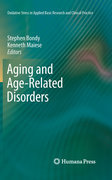
Features that characterize the aging process include the gradual accumulationof cell damage after prolonged exposure to oxidative and inflammatory events over a lifetime. In addition to the accretion of lesions, the intrinsic levelsof pro-oxidant and aberrant immune responses are elevated with age. These adverse events are often further enhanced by the chronic and slow progressing diseases that characterize the senescent brain and cardiovascular system. The incidence of some disorders such as Alzheimer's disease and vascular diseases aresufficiently prevalent in the extreme elderly that these disorders can arguably be considered 'normal'. Aging and Aging-Related Disorders examines the interface between normal and pathological aging, and illustrates how this border can sometimes be diffuse. It explores and illustrates the processes underlying the means by which aging becomes increasingly associated with inappropriate levels of free radical activity and how this can serve as a platform for the progression of age-related diseases. The book provides chapters that examine the interactive relationship between systems in the body that can enhance or sometimes even limit cellular longevity. In addition, specific redox mechanisms in cells are discussed. Another important aspect for aging discussed here is the close relationship between the systems of the body and exposure to environmental influences of oxidative stress that can affect both cellular senescence anda cell’s nuclear DNA. What may be even more interesting to note is that theseexternal stressors are not simply confined to illnesses usually associated with aging, but can be evident in maturing and young individuals. A broad range of internationally recognized experts have contributed to this book. Their aimis to successfully highlight emerging knowledge and therapy for the understanding of the basis and development of aging–related disorders. This monograph relies on the knowledge of internationally recognized experts and provides chapters that examine the interactive relationship between systems in the body, such as the nervous system and vascular system, that can enhance or sometimes even limit cellular longevity. Extensive breadth of collaborators that have worked with us to highlight emerging knowledge and therapy for the understanding of the basis and development of aging – related disorders. INDICE: Protein Redox Regulation Mechanisms in Aging; Nitrosative Stress in Aging – Its Importance and Biological Implications on NF-?B signaling; Intervention with Multiple Micronutrients Including Dietary and Endogenous Antioxidants for Healthy Aging; Advanced Glycation End Products, Rage and Aging; Sirtuins and Mammalian Aging; Estrogenic Modulation of Longevity by Induction of Antioxidant Enzymes; Mitochondrial Respiratory Function Decline in Aging and Lifespan Extension by Caloric Restriction; Methylglyoxal, Oxidative Stress, and Aging; Novel Strategies for Neurovascular Longevity during Aging; Oxidative Stress in Vascular Disease; The Role of Mitochondrial Reactive Oxygen Species Formation for Aging-induced Vascular Dysfunction; Aging, oxidative stress and cardiovascular disorders; Oxidative stress, aging, and cardiovascular disease; Anti-Oxidation as a Prevention of Cardiovascular Diseases - An Effect of Polyphenols; Vascular aging and oxidative stress: hormesis and adaptive cellular pathways; Role of oxidative stress in mediating elevated blood pressure with aging; Melatonin, Oxidative Stress and the Aging Brain; The SAM strain of mice, a higher oxidative stress, age-dependent degenerative diseases and senescence acceleration model; Antioxidants combined with behavioral enrichment can slow brain aging; Role of nitric oxide in neurodegeneration and vulnerability of neuronal cells to nitric oxide metabolites and reactive oxygen species; Free radical-mediated damages to brain in Alzheimer’s disease: Role of acrolein and preclinical promise of antioxidant polyphenols; An epigenetic model for susceptibility to oxidative DNA damage in the aging brain and Alzheimer’s disease
- ISBN: 978-1-60761-601-6
- Editorial: Humana
- Encuadernacion: Cartoné
- Páginas: 500
- Fecha Publicación: 29/09/2010
- Nº Volúmenes: 1
- Idioma: Inglés
